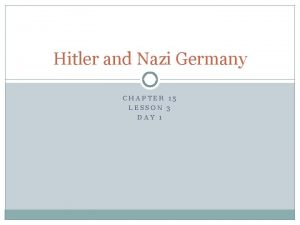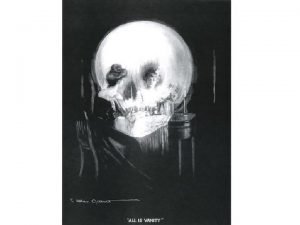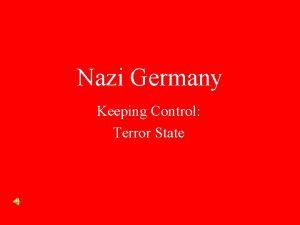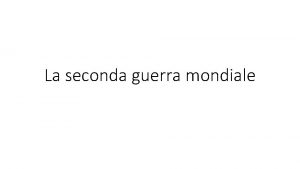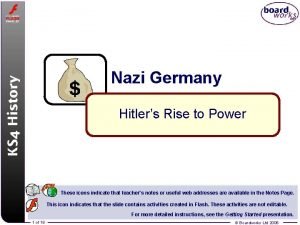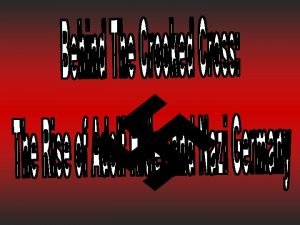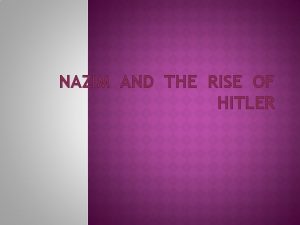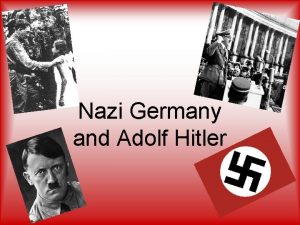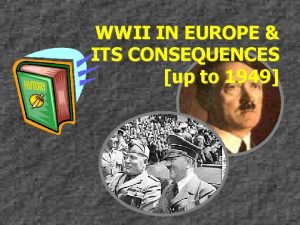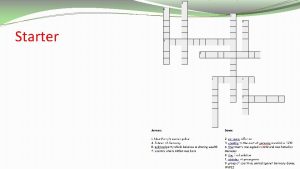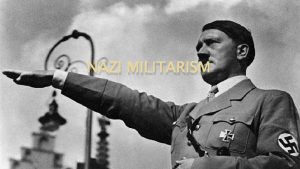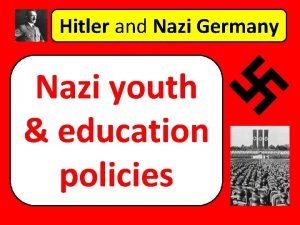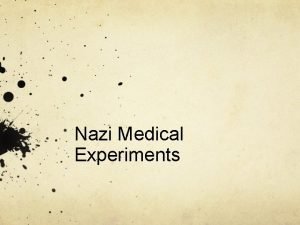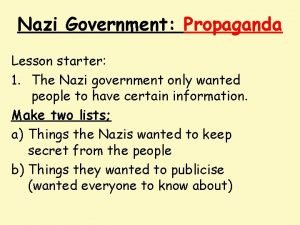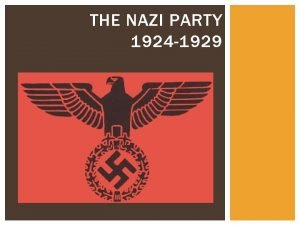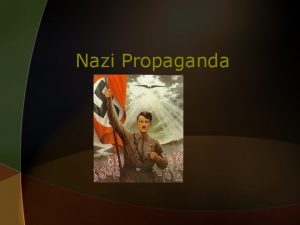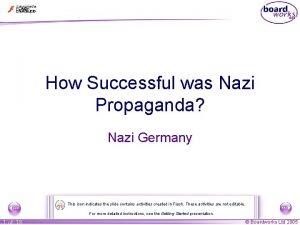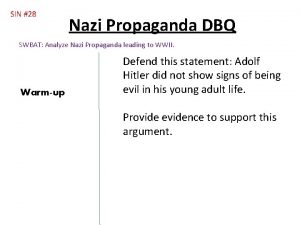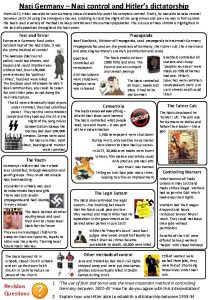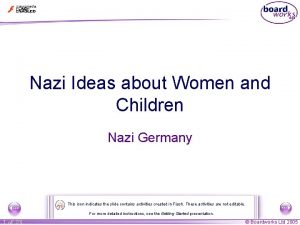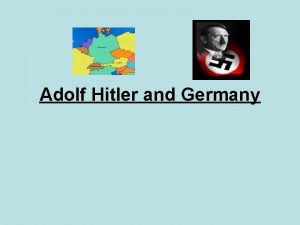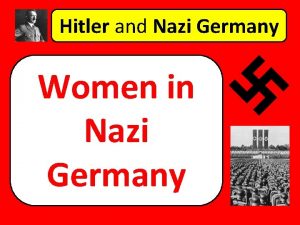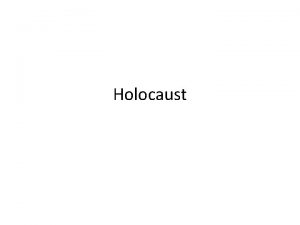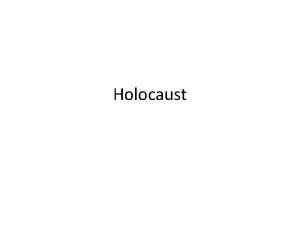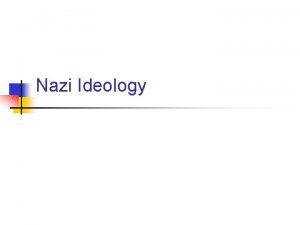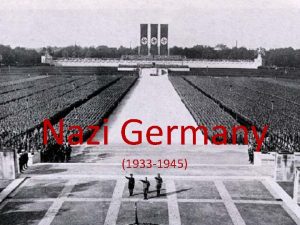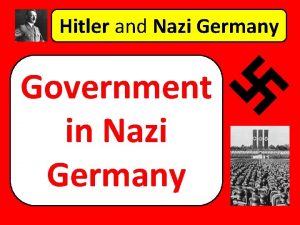The Nazi Economy The Nazi Economy This section


























- Slides: 26

The Nazi Economy

The Nazi Economy • This section of the course examines how Hitler and the Nazis tried to help the German economy recover when they came to power. • There are three questions you can be asked to discuss : • Was there a Nazi economic ‘miracle’? There was the appearance of one, but realistically, no • Did Nazi economic policy work? Yes, as a short term measure. Economic recovery was a facade • What drove Nazi economic policy – ‘Guns or Butter’? Increasingly GUNS as time went on

The Nazi Economy • It was said at the time that the Nazis has worked a ‘miracle’ in fixing the economy. In short, they took credit for turning Germany around from being in an economic meltdown to a fully functional, self sufficient country in a short period of time. • We will be examining the methods that were used to stimulate the economy and how successful these were. • We will be examining whether or not the Nazis can really take credit for the economic recovery after 1933. • We will also discuss the debate about what drove the economic recovery – the need for arms in the lead up to WW 2 or other factors

What you need to know • Stimulating economic recovery • Schacht: his role and significance • Göring and the Four Year Plan • Goals of Nazi foreign policy • Impact of foreign policy on the economy, society and the ‘Hitler myth’ • Creating an economy geared towards war?

Weimar Economic Background • Before examining the Nazi economic policies, it is important to understand the situation that Germany was in by 1933, and what they had been through in the past decade. • The Weimar years had been plagued with economic crises.

1923 – Hyperinflation Crisis • In 1923, Germany missed a reparations payment. • France and Belgium, in retaliation, marched into the Ruhr – the industrial hub of Germany. • They planned on taking what they were owed in the form of goods from the factories in the Ruhr. • In response, Ebert ordered a general strike in the Ruhr and Germans stopped going to work. • This, however, meant that Germany now stopped producing goods and therefore had no money to make through exportation. • To combat this, Ebert and the Weimar Govt started to print more money. • As a result, businesses had to increase their prices to keep up with the influx of money into the economy. • This led to HYPERINFLATION – A massive increase in the price of goods.

Impact of Hyperinflation • Many Germans ended up facing starvation because of the ridiculous price of food due to Hyperinflation. • Many Germans also lost their life savings because money was now worthless. • This was the first economic crisis of the Weimar Govt and many referred to it as ‘the scar that never healed’ – Germans feared another economic disaster.

1924 -29 : The Stresseman Years/Golden Years • In 1924, Gustav Stresseman helped to bring the economy under control. • He brought in a new currency, the Rentenmark which brought the Hyperinflation under control and returned confidence to German economy. • He also helped renegotiate reparations payments under the Dawes and Young plans, which helped Germany get back on her feet. • These years were good for Germany economically and many were happy with the Weimar Govt.

1929 – Wall St Crash leads to Great Depression • In 1929, the US Stock Market crashed. • Businesses and banks had to call in foreign loans in order to stay afloat. • This impacted all of Europe, as America had loaned money to help rebuild Europe after WW 1. • Germany, however, was devastated by this. Their entire economy was reliant on foreign loans, as the Dawes plan gave them loans to help pay reparations. They now had to pay all of this back. • Businesses all over Germany went bankrupt and unemployment soared – many faced starvation and homelessness.

Distinction • It is important not to get mixed up between Hyperinflation (1923) and the Great Depression (1929 onwards) • Hyperinflation caused prices to rise so much that people could not pay for food. • The Great Depression caused unprecedented amounts of unemployment. • However, the end result was the same for everyday Germans – starvation, homelessness and disease.

Hitler 1933 • Hitler came to power in 1933. The economic difficulties actually helped Hitler and the Nazis massively. • He was able to blame the current Government for the crises and he had promised to fix the economy if he came to power. • Germans were extremely worried about their economic future and dealing with the economy was one of the main things they looked to Hitler for.

1930 -32 – Bruning in charge before Hitler • Bruning argued that the German people simply had to ‘tighten their belts’ during the economic depression. • He claimed that the world was in an economic depression and there was nothing Germany could do except wait it out until conditions started to improve – ‘like a storm at sea’. • The Germans, understandably, did not want to hear this. • They looked to Hitler and the Nazis for a quick solution to their problems.

Situation in 1932 • In 1932, the economic depression had ‘bottomed out’ – meaning the worst of it had passed. This suggests that Bruning’s approach had worked – he was just not in power to benefit from it. • In some ways, Hitler was slightly lucky in the recovery of the German economy. • However, the Nazi’s more proactive approach to state intervention and investment was a key reason for the speed of recoverygrowth in the early years of his reign.

Unemployment Late 1932

How did Hitler plan to stimulate economic growth 1933 -36? • Read the first two paragraphs of pg 216 Hinton and Hite and complete Q 1 in the Focus Route box • This is an overview of how Hitler attempted to bring the economy under control in the immediate years after the took control.

How did Hitler plan to stimulate economic growth 1933 -36? • Creating jobs – Public work schemes (eg building Autobahn) would be funded by the state – They would pay companies to do the work who would therefore employ more people. • Stimulating consumer demand – This would therefore lead to people spending more money on consumer goods, also with the help of tax concessions (eg newly weds). • Restoring confidence – destroying independent unions and subsidising private companies to employ more workers and expand production. • Married women and Jews no longer allowed to work • RAD and conscription forced young people into service and off the unemployment register Clever bookkeeping tactics to keep unemployment numbers down.

How did Hitler plan to stimulate economic growth 1933 -36? • In simple terms, Hitler did not intend to do anything drastic or new in terms of economics. • He intended to apply Government spending to create employment and also control prices and wages to avoid another inflation crisis. • Up until 1936, the German economy was not driven by rearmament – it was preparing itself – warming up – in order to vigorously pursue a policy of rearmament in preparation for war.

Hjalmar Schacht • Hjalmar Schacht became Reich currency commissioner in 1923 and was praised for bringing Germany's inflation under control. • Schacht was the man who dealt with the banks under Stresseman during the ‘Golden Years’. • Schacht was rewarded by being appointed president of the Reichsbank. In 1929 he headed the German delegation that negotiated the Young Plan. • He was appointed as the Reich Economic Minister in 1934. This helped appease the economic elite as Schacht had a reputation for being trustworthy and able.

Schacht’s Approach • Schacht’s approach to Germany’s economic growth was one of caution. • He favoured conventional economic policies and a sensible approach to rebuilding the economy. As well as a cautious approach to all other matters of Government. • ‘Guns or Butter’ – As mentioned previously, there is a debate over whether the German economy was driven by rearmament or by focusing on consumer goods – Under Schacht, the economy was driven more by ‘butter’. He was tasked with creating a German economy capable of rearmament, but his primary task was the reduction of unemployment.

Schacht’s Main Measures • Read paragraph 3 on page 216 of Hinton and Hite and complete the Focus Route Q 2.

Schacht’s Main Measures • Mefo Bills (Deficit Spending/Financing) – These were simply IOU’s handed out by the Government. Credit notes were used as payment by the Government when purchasing supplies and services used for rearmament. It meant that companies would continue supplying services even though they were not being paid immediately. Instead, they were given the promise of payment, which they were happy to accept – This meant that the Nazis could now fund public investment which was the main reason for economic growth between 1933 -36. • Suspended debt repayment to boost consumer spending in Germany.

The New Plan • Read Hinton and Hite pg 216 or the information you have been given by your teacher. • In your own words, describe the ‘New Plan’ and explain how this helped the German economy.

The New Plan • As the economy recovered, Germany faced a new problem – they were importing more than they were exporting and its currency reserves were running low, which would prohibit them from been able to bring in anymore imports as they could not buy from other countries. • Fundamentally, the New Plan allowed Germany to control all aspects of her trade in terms of imports and exports. • The Government now had to approve any imports so they could regulate them. • The New Plan also set up trade agreements with other states, some of which agreed on a bartering system – trading goods for goods instead of money. • This helped Germany balance the books, however did not completely solve the balance of trade problem.

Schacht’s Contribution • In the early years of Hitler’s reign, Schacht was crucial to Germany’s economic growth. • His Mefo Bills were an ingenius way of allowing the Government to increase public spending without the risk of high inflation. As well as this, it allowed the Nazis to start to pursue their policy of rearmament while disguising military expenditure. • His New Plan also allowed Germany to manage their imports and direct them towards ‘key’ industries – such as arms manufacturing. • The increase in public spending had generated employment – Figures fell from 26% in 1933 to 7% in 1936. • Schacht was a cautious and sensible Economic Minister – He ensured Germany did not spend outwith her means (especially with rearmament) and he made sure the economy underwent growth without being put under too much pressure.

1936 – 39 • Despite Schacht’s contribution and skills, Hitler was now gearing up for another war. • He had long wanted to build up Germany’s armed forces and was now in a position where he could aggressively pursue this policy. • Schacht, however, did not agree with this and suggested remaining cautious and focusing more on the production of consumer goods to keep the economy growing. • Hitler did not agree with Schacht…

“when he realised that the moderation of my financial policy was a stumbling block in his reckless plans (in foreign policy), he began, with Goring’s connivance, to go behind my back and counter my arrangements” 1) What does Schacht mean by this quote? 2) What does this suggest Hitler is planning for the economy after 1936?
 Athens vs sparta differences
Athens vs sparta differences Sex boutique london
Sex boutique london William golding nazi
William golding nazi William golding facts
William golding facts Lesson 3 hitler and nazi germany
Lesson 3 hitler and nazi germany Hitler rise to power
Hitler rise to power Nazi club spongebob
Nazi club spongebob Rahowa tattoo
Rahowa tattoo Nazi germany
Nazi germany William golding facts
William golding facts Nazi germany military
Nazi germany military William golding nazi
William golding nazi Imagen de nazi
Imagen de nazi Pavillon nazi
Pavillon nazi Henry madden nazi
Henry madden nazi The courtyard of the old residency in munich (1914)
The courtyard of the old residency in munich (1914) The nazi police state
The nazi police state Nazi germany
Nazi germany Nazi fuck
Nazi fuck Nazi fuck
Nazi fuck Nazi
Nazi Nazi
Nazi Nazi
Nazi 8 stages of the cambodian genocide
8 stages of the cambodian genocide Nazi
Nazi World war 1 allied powers
World war 1 allied powers Nazi symbol
Nazi symbol




